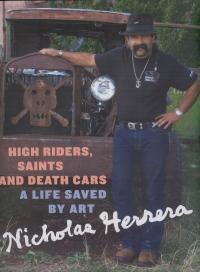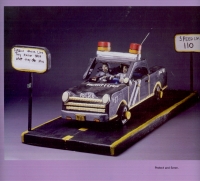| ________________
CM . . . . Volume XVII Number 41 . . . . June 24, 2011
excerpt:
The excerpt above is a typical self-reflection behind the inspiration of the pieces pictured in this biographical scrapbook of folk artist Nicholas Herrera. In a plain direct style, Herrera tells the story of his life to author Elisa Amado, from wild child, through alcohol fueled and wilder still, young adult, to well-respected, successful and sober folk artist. Herrera's story is embedded in the dusty scrub of El Rito, New Mexico. His family arrived in this area not far from Santa Fe with the "Spanish conquistadors in the early 1500s," and Herrera still lives and works there today.
In the Santero tradition, artists were leaders and mentors in their communities. In many respects, this is who Herrera has become. His art has caught the attention of influential art collectors, Chuck and Jan Rosenak, who have included him in an important exhibition of American folk art at the Smithsonian. Like the Santeros of the past, Herrera clearly loves working with young people, who, he says, "...need a guide, encouragement." Also Herrera seems to be casting himself in the role of leader through the social commentary implied in his pieces. But somewhere between the art and the telling of it, there is a disconnect. There are underdeveloped threads of commentary that leave the reader to question Herrera's credibility. Here, he touches on the relationship between Native Americans and his descendants: "The Indians want to make us feel guilty. But we taught them how to use metal and brought sheep and horses." And Herrera does not sound like a role model when he seems to brag about his car, "The Babemobile," which apparently attracts flocks of women. Another problem with the book is its layout which seems amateurish and lacks coherence. A spread of pages is suddenly washed in mauve, and in another example, text is set into a hot pink block for no obvious reason. The placement of photos and text is also quite random. Herrera and his art are interesting and engaging. In the hands of a strong art teacher who is able to show students how to look for the narrative in Herrera's art, this could be a very useful resource. But for most schools and libraries, this book has limited appeal. Recommended with reservations. Heather Kuziw teaches high school art and Charlotte Duggan is a teacher-librarian in Winnipeg, MB.
To comment
on this title or this review, send mail to cm@umanitoba.ca.
Copyright © the Manitoba Library Association. Reproduction for personal
use is permitted only if this copyright notice is maintained. Any
other reproduction is prohibited without permission.
NEXT REVIEW |
TABLE OF CONTENTS FOR THIS ISSUE
- June 24, 2011.
AUTHORS |
TITLES |
MEDIA REVIEWS |
PROFILES |
BACK ISSUES |
SEARCH |
CMARCHIVE |
HOME |

 Herrera's life story is told through a combination of family photos, photos of his work, and text explaining the background of each piece and a description of the connection between the piece and Herrera's life. Herrera takes the traditional santero art form and turns it on its head. Instead of saints and martyrs in stereotypic scenarios, in Herrera's art, we see them in surprising and often jolting scenes: Jesus in the back of a cop car, for example, or the holy family fleeing Egypt on motorcycles while the devil tries to tip off Herod via cell phone. Herrera often uses this form for social commentary; usually as a cautionary tale about a vice that almost destroyed him – alcohol.
Herrera's life story is told through a combination of family photos, photos of his work, and text explaining the background of each piece and a description of the connection between the piece and Herrera's life. Herrera takes the traditional santero art form and turns it on its head. Instead of saints and martyrs in stereotypic scenarios, in Herrera's art, we see them in surprising and often jolting scenes: Jesus in the back of a cop car, for example, or the holy family fleeing Egypt on motorcycles while the devil tries to tip off Herod via cell phone. Herrera often uses this form for social commentary; usually as a cautionary tale about a vice that almost destroyed him – alcohol.